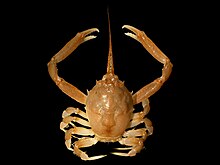| Corystidae Temporal range: | |
|---|---|
 | |
| Corystes cassivelaunus | |
| Scientific classification | |
| Domain: | Eukaryota |
| Kingdom: | Animalia |
| Phylum: | Arthropoda |
| Class: | Malacostraca |
| Order: | Decapoda |
| Suborder: | Pleocyemata |
| Infraorder: | Brachyura |
| Section: | Eubrachyura |
| Subsection: | Heterotremata |
| Superfamily: | Corystoidea Samouelle, 1819 |
| Family: | Corystidae Samouelle, 1819 |
| Genera | |
See text | |
Corystidae is a family of crabs, in its own superfamily, Corystoidea. It includes what was once thought to be the oldest Eubrachyuran fossil, Hebertides jurassica , thought to be dating from the Bathonian (Middle Jurassic); [1] the species was subsequently reinterpreted as being Cenozoic in age. [2] Corystidae contains ten extant and five extinct species in eight genera: [3]
- Corystes Bosc, 1802
- Corystites Lőrenthey, in Lőrenthey & Beurlen, 1929
- Gomeza Gray, 1831
- Gomezinus † Collins, Lee & Noad, 2003
- Harenacorystes † Van Bakel, Jagt, Artal & Fraaije, 2009
- Hebertides † Guinot, De Angeli & Garassino, 2007
- Jonas Hombron & Jacquinot, 1846
- Micromithrax † Noetling, 1881
